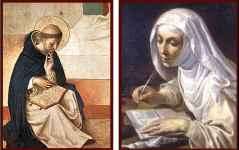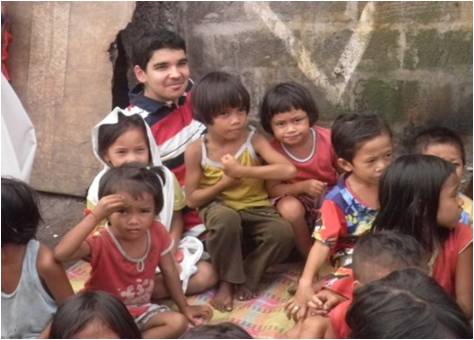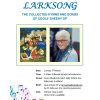 DOMINICAN LAITY
DOMINICAN LAITY
Newsletter #22
June 2012
Dear Friends
VISIT OF FR DAVID KAMMLER OP
In the last newsletter you may have read about Teresa McNamara’s conversation with Fr David Kammler, Promoter for the Laity in the Dominican Order. David is based in Rome, but travels the world making contact with lay Dominican groups of all kinds.
Fr David has now confirmed that he will visit New Zealand in February-March 2013.
It is a delight and a privilege to have him with us. For three weeks he will travel about New Zealand, meeting with lay people in a variety of places, hearing our stories, seeing the kinds of work that lay Dominicans are engaged in, and speaking with us about the mission of lay Dominicans. In some places he will also speak to a wider audience about the role of the laity in the Church.
This is a wonderful opportunity for us to reflect on how lay Dominicans can play a more vibrant part in the Christian mission for New Zealand. If you are able to assist in organising and supporting Fr David’s visit, please contact one of the people listed here (along with the dates David will be in your area):
26 Feb-3 MarAuckland Teresa McNamara [teresa.mcnamara@xtra.co.nz]
3 -7 MarPalmerston North/Wellington Mike and Jenny [kelly.wilson@ihug.co.nz]
8-12 MarDunedin/Oamaru Moira Gallagher [moirapgall@gmail.com]
13-15 MarInvercargill Tui Pasco [goff@paradisse.net.nz]
16-18 MarQueenstown Norman Gray [kf7iknlg@earthlink.net]
SURVEY OF DOMINICAN LAITY
In preparation for Fr David’s visit, we would like to put together a profile of lay Dominicans in New Zealand – who we are, how we made a connection with the Dominican order, how we live out our Dominican call, what it means to us to have this connection.
Norman Gray has compiled a survey, which he will be sending to you within the next few days. Please take time to follow it through (you can do it all online!) and send your responses to the questions.
This will be a valuable exercise in understanding just who we are.
……………………………………………………………………………………………………………
Come follow me
An experience of volunteering for Dominican Volunteers International
Recently, a member of Dominican Volunteers International visited Auckland. Teresa McNamara writes about his visit.
Dominican Volunteers International (DVI) was established in 2000 as a way to engage lay people (and young people in particular) to participate in the preaching mission of the Dominican Order. The programme draws on the various talents that lay young people bring.
Luke Samy is an Australian who after spending five years studying and lecturing at Oxford University in the UK felt motivated to respond to the words of St Thomas Aquinas when he wrote that he “would rather feel compassion than know the meaning of it”.
Slum children using Luke as a couch in the street, during catechesis
Responding to a call to go on mission Luke found himself in the Philippines where he has been catechising the children of the slums, providing moral support to leprosy patients and teaching the children of leprosy patients everything from statistics to morality!
Luke explained how DVI works by sharing his own journey. The process starts with a volunteer who has the desire to preach the gospel. The volunteer is usually someone associated with the Dominican family – a parish, school, community etc.
This group becomes the sending community who provides some formation prior to the mission. They also provide spiritual support while the volunteer is on mission.
Luke’s sending community is Black Friars at Oxford. Luke already knew the Dominicans as he attended Mass there and when he came to know about DVI he thought this would be a pretty cool experience.
The sending community sends a letter of recommendation to Santa Sabina in Rome. There the international co-ordinator Sr Lucia Fernandez finds a community in the world that really needs the particular skills of that volunteer. Volunteers will always go to a country where people speak their language. Usually English speakers are placed in communities in Cambodia, Indonesia, Thailand, Nigeria, South Africa, Trinidad &Tobago and Zimbabwe.
Typically volunteers have a choice of three places of mission—known as the “receiving community”. Luke went on mission to San Lorenzo Ruiz in Dagatdagatan in the Philippines.
Most volunteers teach religion or do catechesis. What you do depends on what the community needs are. One volunteer in the Dominican Republic preached on the radio, some teach trade skills, others keep the accounts or do administration. There is a range of missionary experiences. It depends on the skills of the volunteer and how they match the needs of the receiving community. Volunteers help in whatever way they can.
One of the key objectives of DVI is to expose volunteers to situations of extreme poverty or suffering in order to show how the Church responds to the needs of the poor in the frontiers of global society.
Dagat-dagatan is one of the poorest areas in Manila. It was designed to be a place where people living in the slums would be relocated to improved housing but due to corruption the area became a dumping ground for people living in slums in other areas. One-third of the people in this area live under the poverty line. Half are unemployed and others only have part time or casual work. Nobody has fulltime employment. The area has very specific needs. Spare time leads to a high crime rate which adds to the suffering of people. Luke teaches religion at the primary school and catechesis to the children in the slums.
Greater and deeper knowledge of what our Lord says in the gospels. We must become like little children in order to inherit the kingdom.
Luke shared that the words “in order to inherit the Kingdom of God you must be like a little child” had always surprised him. His experience of being on mission and teaching children in the slums has helped him understand these words.
The slum children are loving, joyful, open and affectionate children. They show the most affection you will find anywhere. The Lord presents the children as a model for the rest of us.
Twice a week Luke joins two Filipino volunteers to teach catechesis to the slum children. As the group arrive the children shout their names and jump all over them. The lesson takes place on the street outside the homes of the children with no tables or chairs or other aids for teaching. The classes begin with prayers and singing followed by a short talk about a Saint or upcoming feast. The lesson is reinforced by some written exercises. During the lesson the children sit on Luke like he is a couch.
Luke reflected how Jesus must have experienced the same thing when he entered a town and was welcomed but remember too that He received rejection from some.
The openness of the children helped Luke to accept his most challenging assignment. Luke was transferred to Tala which was the old leper colony of the Philippines. Today leprosy is a perfectly curable disease and isolation is no longer required by law however there is still a great stigma surrounding it. Tala remains home to over 80 patients whose families are too poor or too afraid to look after the family member.
Luke was incredibly afraid of catching leprosy. A talk with the head nurse designed to allay his fears magnified his fears not only of getting leprosy but also of contracting TB.
One of the priests invited Luke to pray the rosary with the lepers. Luke was assured he wouldn’t need to touch the lepers. The hospital neglects these patients so it is very smelly. Luke was careful not to touch the prayer leaflets in case he got leprosy.
A profound thing happened as they prayed the Our Father and then the Hail Mary. He saw the truth ~ that these people are human beings … they too are children of God. They too yearn for healing and salvation. They have a desire to love and be loved. They too are made in the image of God. Suddenly Luke’s image of ugly deformed people was replaced with beautiful people of prayer.
Luke’s attitude changed completely. Now he was eager to hug them, to talk to them, to joke with them and to become their friend. As Luke walked home that evening he realised a special grace had been given to him.
He thought about the words “and you shall know the truth and the truth shall set you
Luke encouraged others to consider mission opportunities. The only thing you need is the will and desire to preach to others and to have a heart for the poor and the suffering. Christ doesn’t rely on your talents – God will release potentialities that you never knew were there. Christ will supply the qualities you are lacking.
Luke concluded his talks with the words of Blessed Pope John Paul II: “I ask young people themselves to listen to Christ’s words as he says to them what he once said to Simon Peter and to Andrew at the lakeside: “Follow me, and I will make you fish for people (Mt 4:19). May they have the courage to reply as Isaiah did: “Here am I Lord! I am ready! Send me! They will have a wonderful life ahead of them, and they will know the genuine joy of proclaiming the Good News to brothers and sisters whom they will lead on the way to salvation”.
……………………………………………………………………………………………………………..
Extracts from journals of Fr Peter Murnane, currently living in Solomon Islands.
April 2012..I have always been fascinated by snakes, and even in childhood wanted a carpet snake – a non-poisonous python – as a pet. They say if we live long enough we fulfil all our ambitions. One of the novices found a miniature python in the bush, and – having heard me say it would be good to have one to control rats – brought it home in an old bottle. He kept apologising that it was so small – it would hardly stretch to 40 cm, and is 1cm thick, so the rats are fairly safe for some time to come. On its pale brown length it wears a beautiful pattern in darker brown. I had soon rigged up a snake-house: a clear plastic 4-litre oil bottle with top cut off. From an internet group of python fanciers I learned that it is a “Solomon Islands tree boa” – candoiabibroniaustralis. There is a ground version, but ours left no doubt by quickly climbing the small branches in its house. Moreover, it loves to climb a larger branch stuck in an old altar-wine bottle (water-filled for stability). It ties itself into a knot (they are also known as ball pythons), and stays there patiently in my room or on the table in the common room. Our cook and one novice is afraid of snakes. Our Malaitan novice reports that snake-keepers in Northern Malaita are at once suspected of sorcery. It was neat that the gospel on St Mark’s feast (Mk 16:18) challenges such fears.
But what to call our supple friend? It took a day for the obvious to strike me: Monty Python! But it’s a girl, so it has to be Montithe French (?) version. She will grow to a metre or more in length: big enough to handle those rats. She may live more than 20 years, but she won’t cost much to keep, for she will eat only every two or three weeks: in her youth a small frog or a couple of grasshoppers. At a metre, she will be strong, and take some handling: perhaps best left in the ceiling then, to attend to any rats by herself.
Although she spends much of the time soaking in the water at the bottom of her jar, Monti seems to enjoy gliding around or snuggling, unafraid, into my hand. I find it awesome to watch at close quarters the unique behaviour of a snake: how it moves by three different methods: creeping on belly scales; pushing off from anchored points; “squirming” by curving its body. Curled around an upright stick, it extends about one fifth of its length, pretending to be a dead branch. It likes to rest its head in a fork, or along a leaf. And to ponder that every creature has its own habits and private life equivalent to this… the astonishing, vast network of created evolution!
May 2012.
Friends of other species – OR: Monti has a mate!
(Those who don’t like spiders can skip the next four paragraphs)
A huntsman spider lives in my room. Like the geckos that wander the walls and ceiling and hang around – literally, for upside down they walk and run around the ceiling lights. Spider is welcome to stay as long as he likes, for like them he eats insects: mosquitoes! And cockroaches! Yes, occasionally one creeps under the door. And here they are those supersized ones. All told, I’m glad I sleep in a mosquito net.
For a time Spider lived in my shower/toilet. This is built of cement brick, so it’s where I will be spending the day if/ when a cyclone comes this way next season. I would find him behind the door, just to surprise me when I closed it. Once he hid on the underside of the shower tap, curled up so that I almost grabbed him when I went to turn it on.
One day I thought Spider was asleep or dead in a corner of the shower cubicle. To my surprise he had merely shed his latest skin, which he had grown too large for, and left it there like four pair of discarded trousers – think about it!
(Non-spider people may resume here)
Then there are the cane toads. Yes, sadly, they have arrived on our little island, as they have at Kolombangara, and in Guadalcanal. As in Brisbane and half of Australia, you can see many on the lawn at night, catching their insects and waiting to poison any unsuspecting critter that would eat them. One morning I came out of my room at 6am to find a little toad sitting at my door, looking expectantly upwards, as if waiting for me with a message. Less than 3 cm long, he was quite cute – for a toad.
Birds: On Loga we see the familiar black and white flycatcher, a larger version of the Australian Willy Wagtail; the occasional kingfisher; parrots; cockatoos; a large pigeon (more often heard by its goofey call, than seen) two kinds of eagle, the “red-beaks” (pukekos/ swamp hens) etc etc. But in Honiara, almost the only bird to be seen or heard is the Indian mynah, that cheeky and bullying bird that seems to have driven away all other species. Mynah’s have not yet reached Gizo or Loga, and it’s to be hoped they never cross the 100km+ gaps between the islands to get here.
I realised only lately: there are no seagulls here. In four months, I have seen none of the silver gulls that thrive on every Australian beach; nor the bigger Pacific (black backed) gull. Its Latin name calls it the Dominican Gull! It thrives on Auckland rubbish bins… how embarrassing for us friars! However we do have the awesome, high-flying frigate birds and various other sea-birds chase the fish schools.
And Monti (the pet python) now has a mate. These little tree pythons are quite common here, so a novice brought another he had found. He – yes! – now shares the roomy tank with Monti, and a firm friendship is developing. I don’t enquire about their nocturnal activities, but it is rather sweet to see them sleeping, half submerged in the water, their heads touching on a leafy pillow. I can almost hear him murmuring: “I’d love to put my arm – if I had arms – around your shoulder… if you had shoulders”.
……………………………………………………………………………………………………….
Peace and blessings
Mike Kelly and Jenny Wilson
Co-ordinators
Ph 06 370 2084 Email: kelly-wilson@ihug.co.nz









